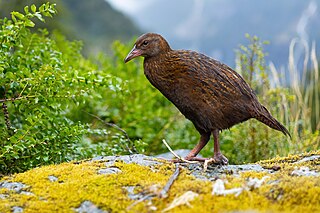
The weka, also known as the Māori hen or woodhen is a flightless bird species of the rail family. It is endemic to New Zealand. Some authorities consider it as the only extant member of the genus Gallirallus. Four subspecies are recognized but only two (northern/southern) are supported by genetic evidence.

The square-tailed drongo, formerly the common square-tailed drongo, is a passerine bird in the family Dicruridae. It is a common resident breeder in parts of southern Africa.
The Calayan rail is a flightless bird of the rail, moorhen, and coot family (Rallidae) that inhabits Calayan Island in the Philippines. It is the only member of the genus Aptenorallus. Though well known to natives of the island as the "piding", it was first observed by ornithologist Carmela Española in May 2004 and the discovery was officially announced on August 16, 2004.

Sharpe's longclaw is a passerine bird in the longclaw family Motacillidae, which also includes the pipits and wagtails. It is endemic to Kenya.

The slaty-breasted rail is a rail species native to the Indian Subcontinent and Southeast Asia. Breeding has been recorded in July near Dehradun in the foothills of the Indian Himalayas. Despite traditionally being considered part of Gallirallus, recent genetic studies have consistently placed it in the genus Lewinia, which is now formally recognised by the IUCN and IOC.
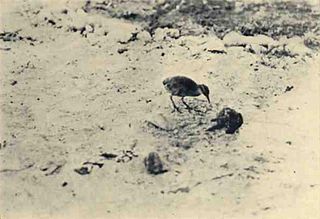
The extinct Wake Island rail was a flightless rail and the only native land bird on the Pacific atoll of Wake. It was found on the islands of Wake and Wilkes, and Peale, which is separated from the others by a channel of about 100 meters. It was hunted to extinction during World War II.

Gallirallus is a genus of rails that live in the Australasian-Pacific region. The genus is characterised by an ability to colonise relatively small and isolated islands and thereafter to evolve flightless forms, many of which became extinct following Polynesian settlement.

The New Caledonian rail is a large and drab flightless rail endemic to the island of New Caledonia in the Pacific. It is Critically Endangered, may have gone extinct many decades ago already, and if it still exists it is one of the least-known living bird species.

The Tahiti rail, Tahitian red-billed rail, or Pacific red-billed rail is an extinct species of rail that lived on Tahiti. It was first recorded during James Cook's second voyage around the world (1772–1775), on which it was illustrated by Georg Forster and described by Johann Reinhold Forster. No specimens have been preserved. As well as the documentation by the Forsters, there have been claims that the bird also existed on the nearby island of Mehetia. The Tahiti rail appears to have been closely related to, and perhaps derived from, the buff-banded rail, and has also been historically confused with the Tongan subspecies of that bird.

The buff-banded rail is a distinctively coloured, highly dispersive, medium-sized rail of the rail family, Rallidae. This species comprises several subspecies found throughout much of Australasia and the south-west Pacific region, including the Philippines, New Guinea, Australia, New Zealand, and numerous smaller islands, covering a range of latitudes from the tropics to the subantarctic.

The invisible rail, Wallace's rail, or drummer rail is a large flightless rail that is endemic to the island of Halmahera in Northern Maluku, Indonesia, where it inhabits impenetrable sago swamps adjacent to forests. Its plumage is predominantly dark slate-grey, and the bare skin around its eyes, the long, thick bill, and the legs are all bright red. Its call is a low drumming sound which is accompanied by wing-beating. The difficulty of seeing this shy bird in its dense habitat means that information on its behaviour is limited.
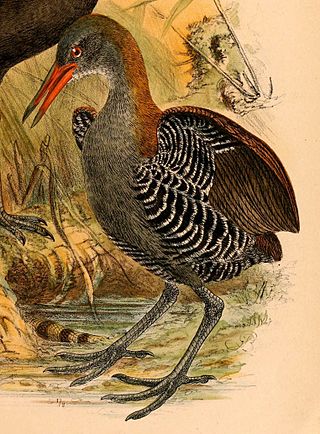
The snoring rail, also known as the Celebes rail or Platen's rail, is a large flightless rail and the only member of the genus Aramidopsis. The species is endemic to Indonesia, and it is found exclusively in dense vegetation in wet areas of Sulawesi and nearby Buton. The rail has grey underparts, a white chin, brown wings and a rufous patch on the hind-neck. The sexes are similar, but the female has a brighter neck patch and a differently coloured bill and iris. The typical call is the snoring: ee-orrrr sound that gives the bird its English name.

The Chatham Islands rail, also known as the Chatham rail is an extinct flightless species of bird in the family Rallidae. It was endemic to Chatham, Mangere and Pitt Islands, in the Chatham archipelago of New Zealand. The Chatham Islands rail was first discovered on Mangere in 1871, and 26 specimens collected there are known from museum collections. Its Māori name was "mātirakahu".

Swinhoe's rail is a species of bird in the family Rallidae occurring in northeastern Asia. It was known only in two locations in Manchuria and southeastern Siberia, separated by more than 1000 km; however, in 2018, a new breeding population was found in the Amur region, situated between the two. Its natural habitats are swamps, freshwater lakes, freshwater marshes, and arable land. It is the world's smallest rail at 13 cm (5.2 in) and 24.5 grams. It is threatened by habitat loss, and considered a vulnerable species on the IUCN Red List.

Dieffenbach's rail, known in the Moriori language as meriki or mehoriki, is an extinct flightless species of bird from the family Rallidae. It was endemic to the Chatham Islands.

The Okinawa rail is a species of bird in the rail family, Rallidae. It is endemic to Okinawa Island in Japan where it is known as the Yanbaru kuina. Its existence was only confirmed in 1978 and it was formally described in 1981 although unidentified rails had been recorded on the island since at least 1973 and local stories of a bird known as the agachi kumira may refer to this species.

The barred rail is a species of rail found across the Philippines, Sulawesi (Indonesia) and Salawati. The species is common, but shy and difficult to see.

Sharpe's akalat is a species of bird in the family Muscicapidae. It is found in Tanzania and northern parts of Zambia and Malawi. Its natural habitats are boreal forests and subtropical or tropical moist montane forests.
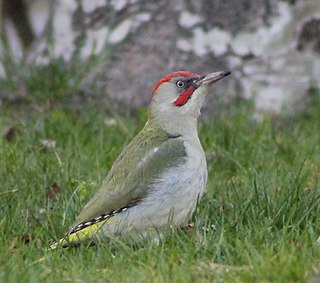
The Iberian green woodpecker is a medium-sized woodpecker endemic to the Iberian peninsula. It was formerly considered as a subspecies of the European green woodpecker but differs in having little black on the head and a dusky rather than a black ring around each eye. Its sound has been described as sibilant, or hiss-like.
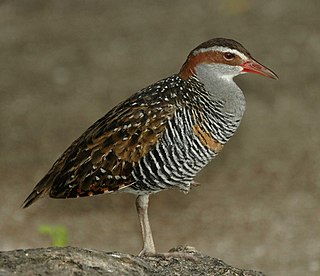
Hypotaenidia is a genus of birds in the family Rallidae. The genus is considered separate by the IOC and IUCN, while The Clements Checklist of Birds of the World / eBird consider the species to be part of Gallirallus. Since the mid-19th century, when these rather terrestrial birds were recognized to form a genus distinct from the decidedly aquatic Rallus, the validity of Hypotaenidia has been disputed.


















